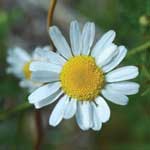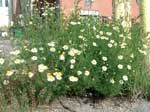Corn Chamomile
Anthemis arvensis L.
Keys to Identification
- Has no odor
- Small daisy-like flowers
This information courtesy of the Colorado Natural Areas Program.
Family
Asteraceae (Sunflower)
Other Names
Scentless chamomile, chamomile, mayweed.
USDA Code
ANAR6
Legal Status
Colorado Noxious Weed List B
Identification
Lifecycle
Annual
Growth form
Forb
Flower
Flowers are 3/4 in wide and are borne at the ends of branched stems. Flowers resemble daisies with white ray flowers and yellow disc flowers. Mid-May-Sept.
Seeds/Fruit
Seeds (achenes) are dark brown and grooved.
Leaves
Leaves are alternate and finely dissected.
Stems
Mature plants are 10-30 in tall. Stems are erect, smooth, and highly branched above.
Roots
Dense fibrous root system.
Similar Species
Exotics
Scentless chamomile(Matricaria perforata)is common on the western slope, and is sometimes confused with corn chamomile(Anthemis arvensis) or mayweed chamomile(Anthemis cotula). Corn chamomile is almost identical to mayweed chamomile but can be identified by its lack of odor.
Natives
The nativeHymenopappus newberryihas few stem leaves, and is perennial.
Impacts
Agricultural
Corn chamomile can reduce crop production. It is considered unpalatable to livestock and its feed value is poor (Woo et al. 1991).
Habitat and Distribution
General requirements
Corn chamomile is commonly associated with newly disturbed habitats. It is found along roadsides, ditches, in urban areas, waste places, cultivated fields, and pastures. It can grow in a wide range of soils but seems to prefer moist, poorly drained soils. Corn chamomile prefers moist areas and increases in abundance during years of above average precipitation.
Distribution
Not yet widespread in Colorado.
Historical
Corn chamomile is a native of Europe that was introduced into North America as an ornamental or seed contaminant.
Biology/Ecology
Corn chamomile germinates readily in the spring and fall. It has a dense, fibrous root system, which spreads rapidly during wet periods. Late summer and fall-germinated seedlings may overwinter as rosettes. In the spring, bolting commences with the elongation of the central stem. Overwintering plants flower in mid-May and spring germinated seedlings flower in June. Flowering stops after a killing frost, usually in October.
Mode of reproduction
Corn chamomile germinates readily in the spring and fall. It has a dense, fibrous root system, which spreads rapidly during wet periods. Late summer and fall-germinated seedlings may overwinter as rosettes. In the spring, bolting commences with the elongation of the central stem. Overwintering plants flower in mid-May and spring germinated seedlings flower in June. Flowering stops after a killing frost, usually in October.
Seed production
Corn chamomile is a prolific seed producer and can produce up to 960,000 seeds per plant.
Seed bank
Seed may remain viable in the soil for 4-6 years.
References
Colorado Natural Areas Program. 2000. Creating an Integrated Weed Management Plan: A Handbook for Owners and Managers of Lands with Natural Values. Colorado Natural Areas Program, Colorado State Parks, Colorado Department of Natural Resources; and Division of Plant Industry, Colorado Department of Agriculture. Denver, Colorado. 349 pages.
USDA, NRCS. 2005. The PLANTS Database, Version 3.5 (http://plants.usda.gov). Data compiled from various sources by Mark W. Skinner. National Plant Data Center, Baton Rouge, LA 70874-4490 USA
Whitson, T.D.(ed.), L.C. Burrill, S.A. Dewey, D.W. Cudney, B.E. Nelson, R.D. Lee, R. Parker. 1996. Mayweed chamomile. Weeds of the West. Western Society of Weed Science, in cooperation with the Western United States Land Grant Universities Cooperative Extension Services, Newark CA. pg. 55.
Woo, S.L., A.G. Thomas, D.P. Peschken, G.G. Bowes, D.W. Douglas, V.L. Harms, and A.S. McClay. 1991. The biology of Canadian weeds. 99. Matricaria perforata Merat (Asteraceae). Canadian Journal of Plant Science 71: 1101-1119.



